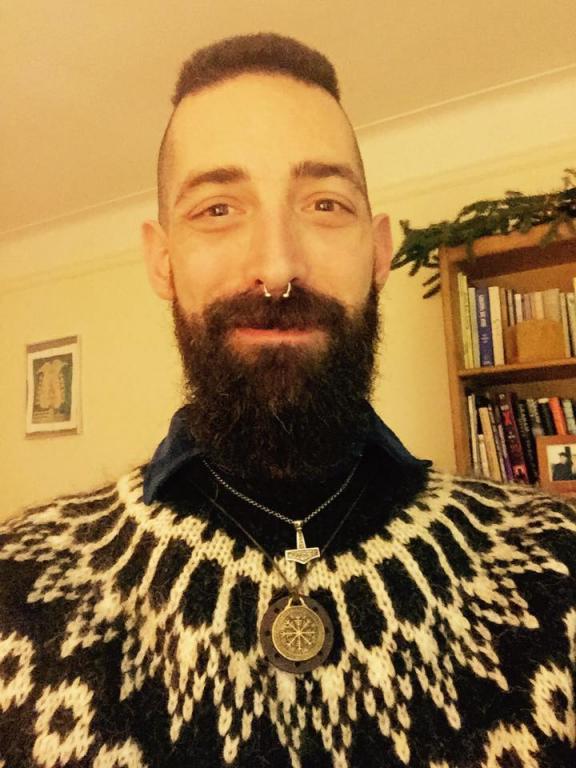I will start by prefacing that this piece is much longer than most I have written, and while it may offer a play by play of what took place several months ago, it was also written as a rudimentary guide on where to start crafting a Heathen interfaith ceremony.
One may jump straight to the summation if they choose, though I encourage reading through and hopefully experiencing the moving and memorable details of an unparalleled day.
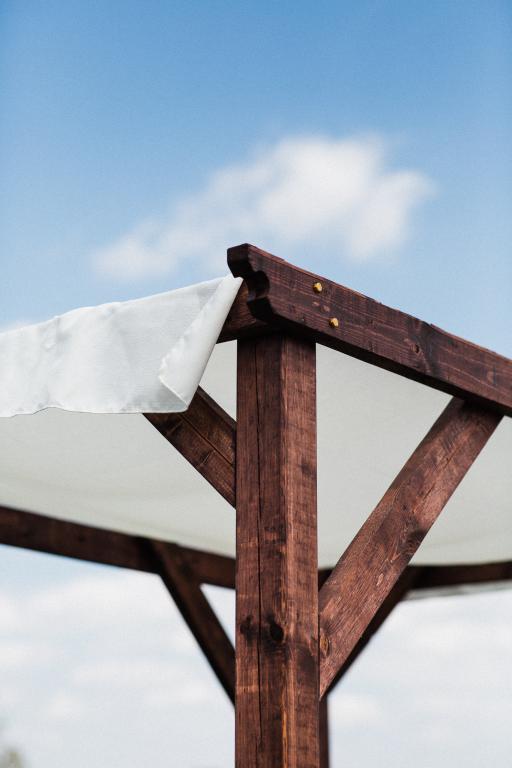
It was a beautiful and sunny day that was flanked by midwestern storm fronts. We stood at the altar before gods and kin and swore oaths to one another; and as promised by all those wedding books and blogs, it was over before we knew it! Immediately following the ceremony we retreated to a private corner. No receiving line or social chit-chats, we would have time for that later.
In Ashkenazi Jewish wedding tradition this is called “Yichud” (איחוד) or bonding, and a necessary step for the couple to sit with one another and absorb the impact of everything that just took place. While we were reflecting this amazing thing we both have done, I asked myself: “how did we get here?”. Not “here” as in getting married, but how did we manage to cobble our own wedding together; especially one as vibrant, exciting, and unique as ours. A wedding that turned out to be a perfect amalgamation of Christian and Heathen faiths that some might otherwise consider in direct opposition to one another.
My wife is a Lutheran Christian (ELCA denomination) who never imagined that she would find herself marrying a Heathen. Our interfaith marriage would cement the foundation of an interfaith household, so ideally it should begin with an interfaith ceremony. Being a Heathen meant that I was off to do some research (I will say this time and again, we are a “religion of study”) and spoiler alert! I came up empty.
What I found were articles, blog posts, and books on interfaith marriages between Jews and Catholics, Buddhists and Christians; and was closest in my search when I stumbled across an article on a Christian and Wiccan marriage. Yet even that one was too far removed from my intended goal. I finally decided that I would go and seek out a Heathen-specific wedding ceremony, and we would construct our own fusion of faiths.
Scouring the internet and books for Heathen weddings, I kept coming across eccentric examples that would better fit a Renaissance faire or other sort of reenactment troupe; with such elements as exchange of keys and swords, flowery old English prose or other such archaic linguistics, as well as ren-faire garb being worn by the bride and groom. And while there are references to some of these in ancient times (such as sword and key), none of these components felt as though they captured Heathen religion or practical spirituality for me – at least not befitting the current times.
I knew that I would need to combine features from several sources in order for our ceremony to have substance and meaning without looking like a sideshow attraction. Thankfully I found an experienced Heathen officiant who would co-officiate alongside our Lutheran pastor. Enter Rev. Kurt Hohmann who shared with me a standalone Heathen wedding ceremony he had written, and together we discussed and edited it accordingly.
Before going into all the details I will state that:
A) A Heathen interfaith wedding ceremony is akin to other interfaith functions in that the components and themes that go into it can be decided on by the couple getting married along with their respective officiant(s).
B) Heathenry being the decentralized reconstructionist faith that it is, allows for a certain malleability when it comes to its ritual structure and who officiates it.
C) It is HARD to let things go (and you will have to). This was and is a perfect example and exercise in cooperation, compromise, and focus. Remember that you both are a team, and neither will be able to reach your intended goal alone.
Sacred Objects
While one may edit their ceremony as they see fit, there are components that modern Heathen practice views as centrally thematic:
The Horn
Integral to Sumbel (the act of passing the horn around as participants speak over it), a filled horn present before a gathering of people echoes all words and actions across all realms and before all gods and beings; where Wyrd is woven into Ørlög – the primal layer of all things.
Incorporated within a Heathen wedding, having a horn to share both in drink and in vows is symbolically and spiritually empowering.
At one point in our discussions my wife asked me, “Does it have to be a horn? Can it be a cup or chalice?” One thing you may come up against will be one party’s ignorance of the other’s faith. Be prepared to explain why certain elements are important to you or to research them further. Knowing and being able to explain what’s most important will help you both to find your best compromise.
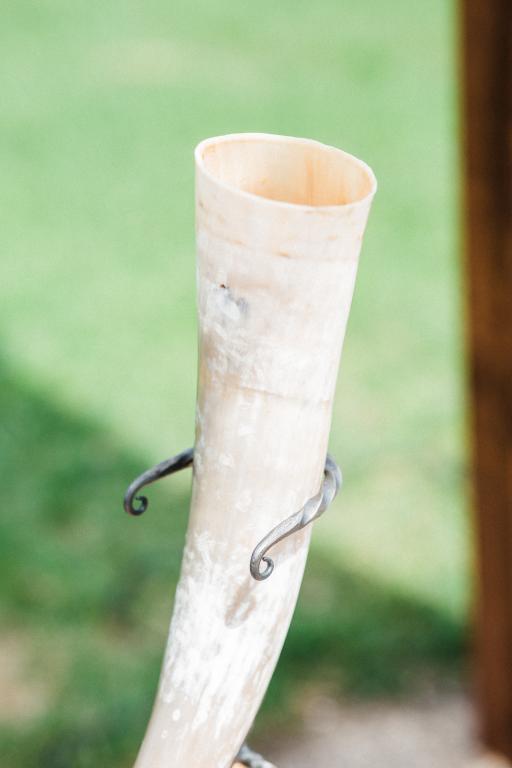
The Oath Ring
Rings have already become such a synonymous symbol of marriage, what’s another? The oath ring is a staple in Heathen tradition; where hands hold it and oaths are sworn upon it. Some consider this holier than sharing a horn and for that reason it is not unusual for non-Heathens to refrain from oathing; just as non-Christians would not partake of Holy Communion for the same reason.
There will be things about this process that are hard. My wife and I discussed this for months. The Oath Ring was a strong point of contention. She felt no connection to the oath ring and did not want to take her vows on what was to her an empty piece of wood. She wanted to hold my hand.
After much back and forth we agreed that the oath ring may be suitably incorporated into the ceremony by tying the two wedding bands on it. They would take on the gravity of the oath ring; and we would take our vows hand in hand. In this way we were able to honor each other’s convictions, and when the time came for the exchange of rings both bands were untied from it.
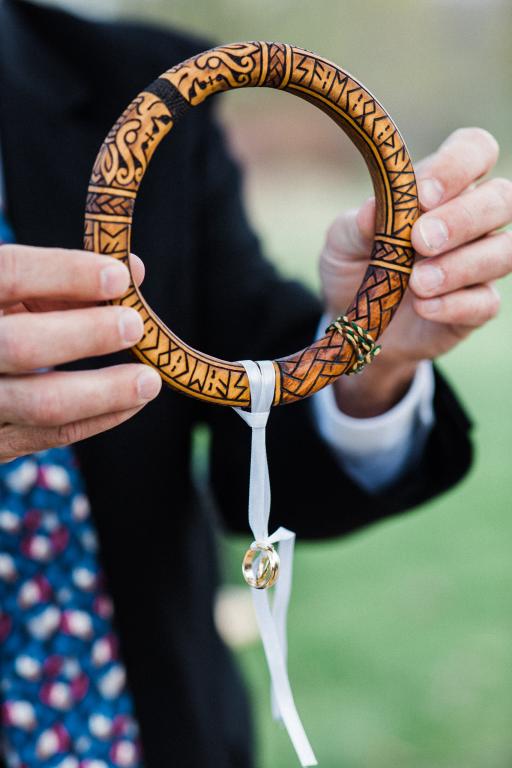
Ritual objects central to Heathenry are relatively easy to incorporate compared to the intricacies of Heathen worship. It was important for my wife and I that both our religions be represented during the ceremony. So the more challenging part was how to incorporate the Heathen gods, the local Landvættir, and our ancestors while also including the Holy Trinity. Overcoming this dilemma was made possible due to the leniency and patience of our Lutheran pastor Andy Behrendt, who was more than happy (and excited!) to co-officiate.
Dividing the Roles
Our ceremony was divided equally between both officiants, but rather than doing the whole thing in one tradition and then again in another, some sections were given to each officiant (i.e. Declaration of Intent = Lutheran, Calling the Gods = Heathen), and others were mainly shared by both Rev. Kurt and Pastor Andy (Pronouncement, Acclamation and Blessings).
Calling God(s)
Without going into the nitty-gritty of theological differences, I happily observed that ELCA Lutheran Christians are REALLY easy-going when it comes to interfaith matters!
Pastor Andy called upon God to witness our marriage during the Call to Assembly with the commitment by my wife and I to seek God’s will in our lives, and in turn to find comfort and joy in each other with this union. Rev. Kurt followed in Heathen fashion by calling upon our ancestors, the local Landvættir, and the gods.
My wife and I felt that the following deities were appropriate for a Heathen wedding (consult your local Heathen clergy for more):
- Odin – granting wisdom to learn from one another.
- Frigg – for the gift of the hearth and safety in marriage.
- Thor – to hallow the marriage and protection through adversity.
Each of these hailings received their own offerings from the mead-filled horn.
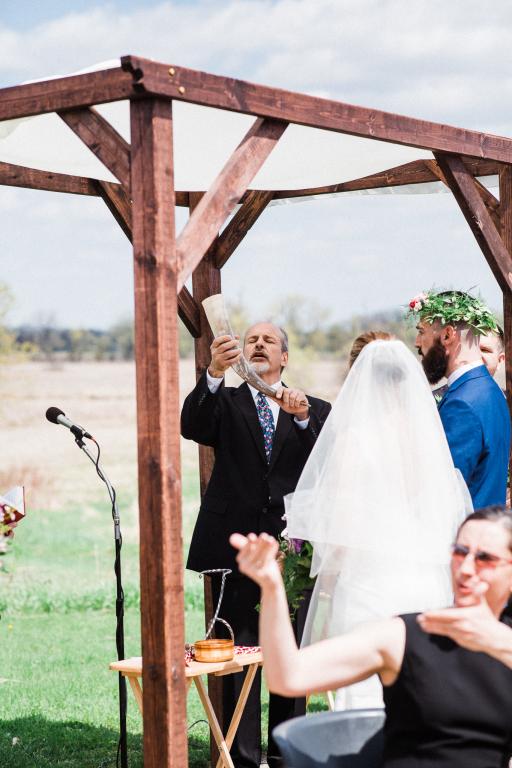
Readings & Sermon
In accordance with Lutheran Christian liturgy, two biblical readings were chosen by us. The Song of Songs 2:10-13 seemed appropriate for the occasion of a springtime wedding (and the least risque out of all the Solomonic love poems) and one I would highly recommend for any interfaith wedding involving a Pagan/Abrahamic faith union. The second reading was from Ecclesiastes 4:9-12. The mention of a “threefold cord” worked perfectly with our intention to handfast, as well as seamlessly bringing together both faiths through an affirming allegory about the strength of two people.
After the readings Pastor Andy masterfully delivered a sermon which included the story of how my wife and I met, along with stellar Star Wars references (we wed on May the 4th). Dutifully mentioned here were Jesus Christ and the love of God; and as the sermon ended with a Christian prayer in the name of the Holy Trinity, I, for the first time in a very long time, recited the word “Amen”. It felt like a promise to myself to respect my wife’s faith as I did my own.
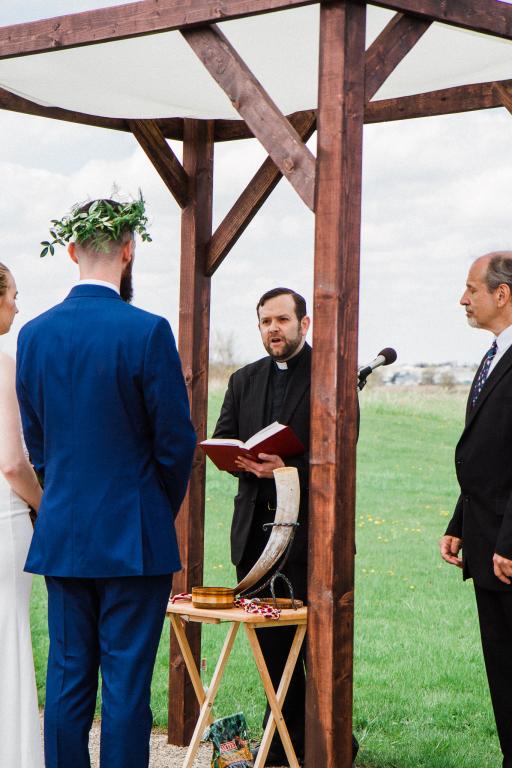
Vows, Rings, and Handfasting
My wife and I then shared a horn and drank to our health as we recited promises to one another. Rev. Kurt took up the oath ring where both our wedding bands were tied together and explained the sacredness of its meaning for those gathered, thereafter each officiant asked us for our vows in turn.
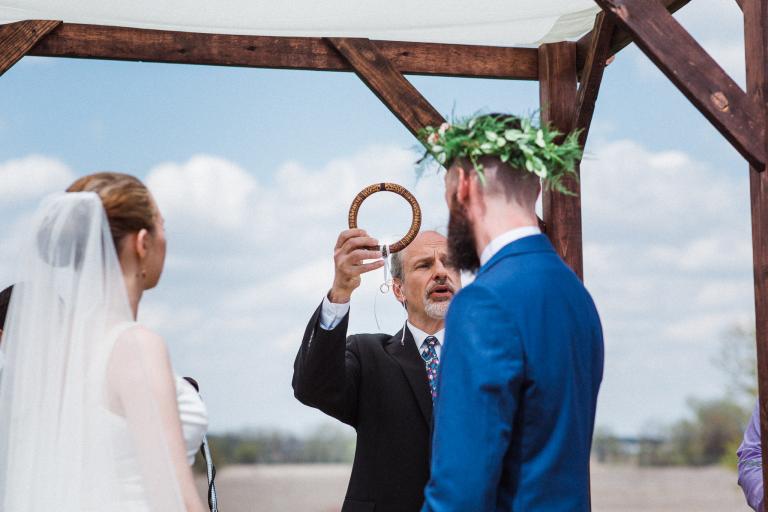
The words spoken were the same as those spoken by many before us:
“I, <Name>, take thee, <Name>, to be my lawfully wedded wife/husband, to have and to hold, from this day forward, for better, for worse, for richer or for poorer, in sickness and in health, to love and to cherish for as long as we both shall live.”
We then exchanged our wedding tokens; they were neither swords nor keys, but beautiful golden rings. My hands were clammy and shaking, so thankfully it was the time for Rev. Kurt to present the handfasting cord (my wife and I made our own together a few nights before) that would be tied threefold strong. Each bond represented Faith (tied by our officiants), Family (tied by my sister and brother-in-law), and Friends (tied by two of our closest friends).
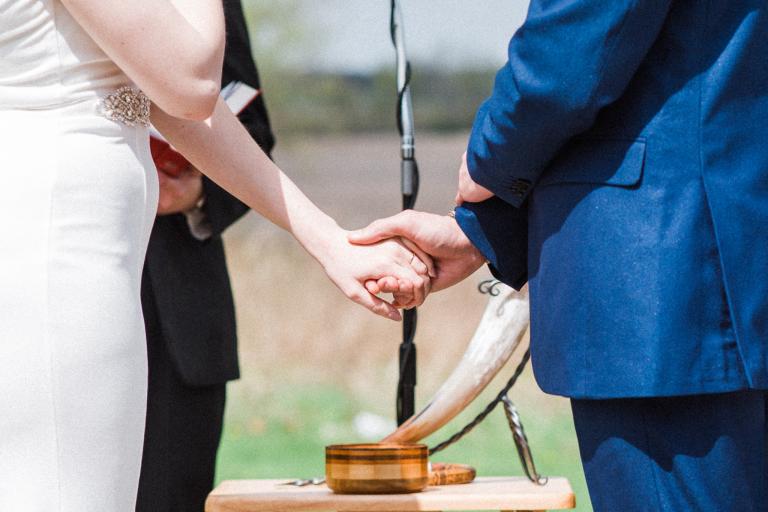
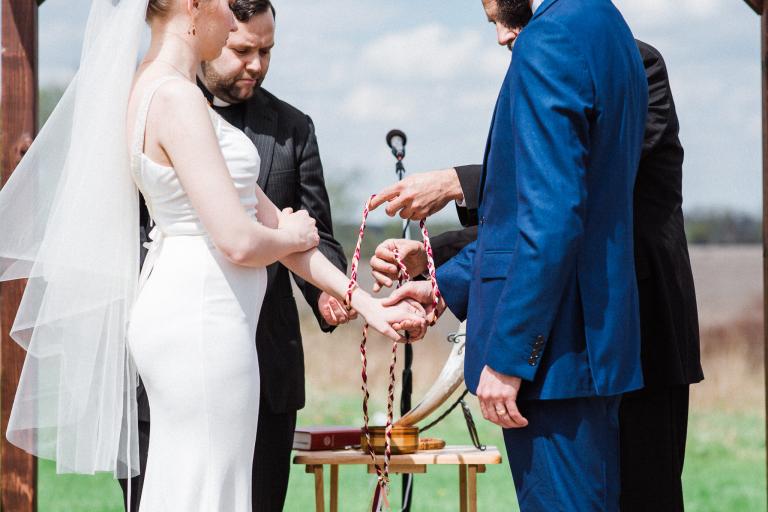
Pronouncement, Acclamation, and Blessings
After all the work, the emotional exhaustion, and moving liturgies, we finally heard Pastor Andy say those seven magical words: “We now pronounce you man and wife!”.
“Hail to the Bride and Groom!” exclaimed Rev. Kurt.
The cacophonous cheering ensued as we kissed.
Both officiants then acclaimed and blessed our union in the name of the Holy Trinity, and by all the gods, the Landvættir, and our Álfar and Dísir.
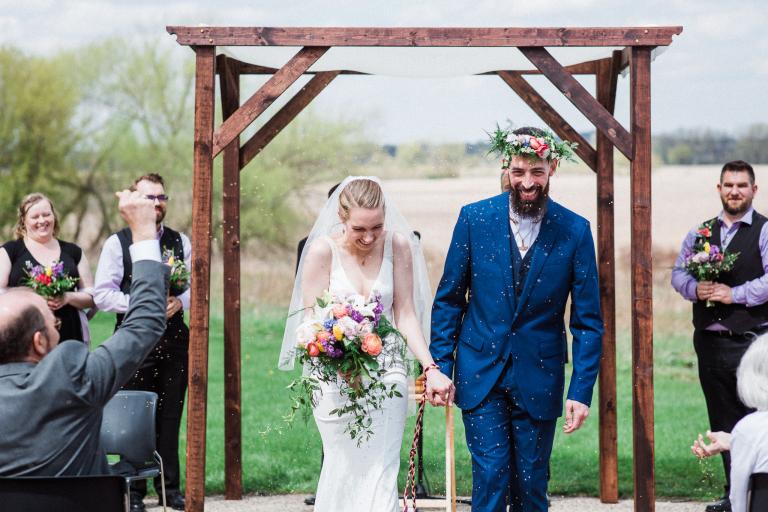
In Summation
Faith is something that each person holds intimately personal and as individuals we tend to instinctively go on the defensive whenever objections toward our faith are expressed (clearly speaking from experience here). Coming together as a couple means that very candid and in-depth discussions must be had so that any issues can be flushed out in detail; anything from how faith would play a role between partners, how children (if any) would be raised, etc.
If there was any repeated piece of advice from the myriad of interfaith articles that I voraciously read, it is that a mutual understanding and respect must be met (sooner rather than later). The more honest the conversation, the easier it will be to temper defensiveness with understanding so that couples can create an amazing marriage that begins with a genuinely beautiful interfaith ceremony.
The ceremony should showcase the marriage and the life one intends to build with their partner. Elements from the religious and spiritual lives of each partner should illustrate the core tenants of their respective faiths (Oath ring, Horn, Cross, Trinity), but more importantly how these potentially differing faiths come together to support the mutual values that are shared (Faith, Kinship, Trust). These pillars are what would ultimately support the spiritual home and beautify it.
Getting to communicate and agree upon a religious median can be tough, so having a good support system that is both caring and knowledgeable is paramount. My wife and I had some rough roads to travel up until we finally said “I do”; but it is thanks to our friends and family for their support, and dare I say curiosity that propelled us forward. And it is with reverence (pun intended) that thanks be owed to our officiants whose knowledge and experience guided the whole ceremony saga into a cohesive and fantastic experience that our guests still talk about months later, and hopefully for years to come.
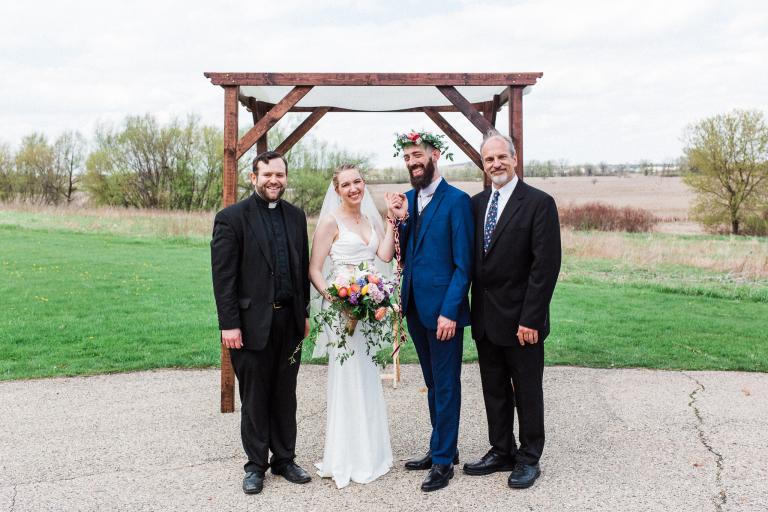
A very special thanks to Rev. Kurt Hohmann, goði of the Úthellingu Kindred of Syracuse, NY; and Pastor Andy Behrendt of Waupaca, WI for their endless good humor and dedication in helping craft a beautiful ceremony for my wife and I.
A note from the wife to those that would attempt such feats:
My loves, permit me to call you that as we are a small group that braves these waters, what you are undertaking is going to hurt. There might be days you wish your soon-to-be spouse wasn’t xyz religion, wish they didn’t care about the ceremony or the flowers or the planning, wish they would just go along and let it be all about you. You might even wonder if these negotiations are worth it.
Allow me to assure you, they are. I wept that we would not be married in a church. Up to the day, I mourned all those little things I had let go for the sake of my spouse’s differing beliefs. I thought somehow the vows and blessings would not be as special because the liturgy was foreign. I was wrong. They were more special because of the effort and care we put into each and every piece, more special because we chose to uplift each other. You might leave this process feeling ready to negotiate an international peace treaty. Cherish every lesson, my loves. You will learn so much.


